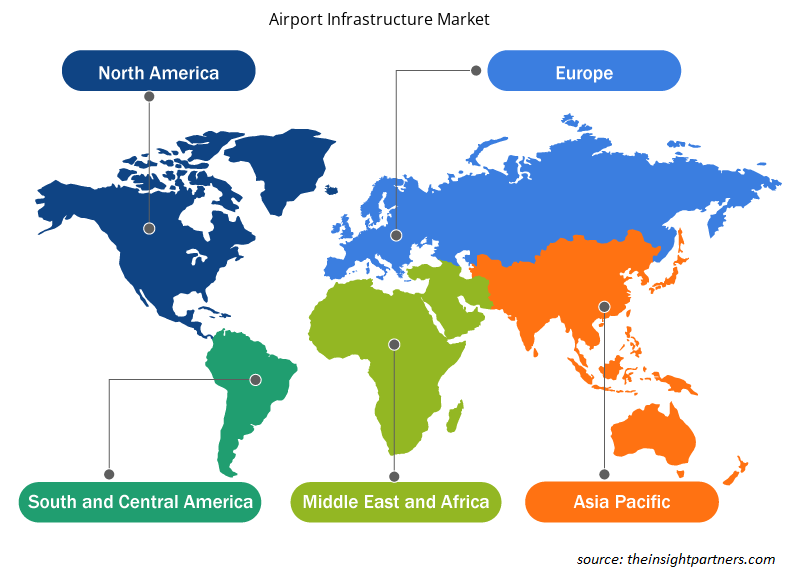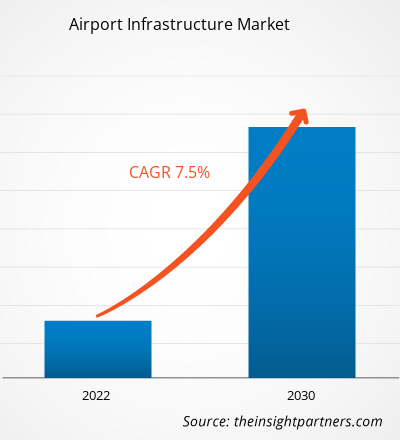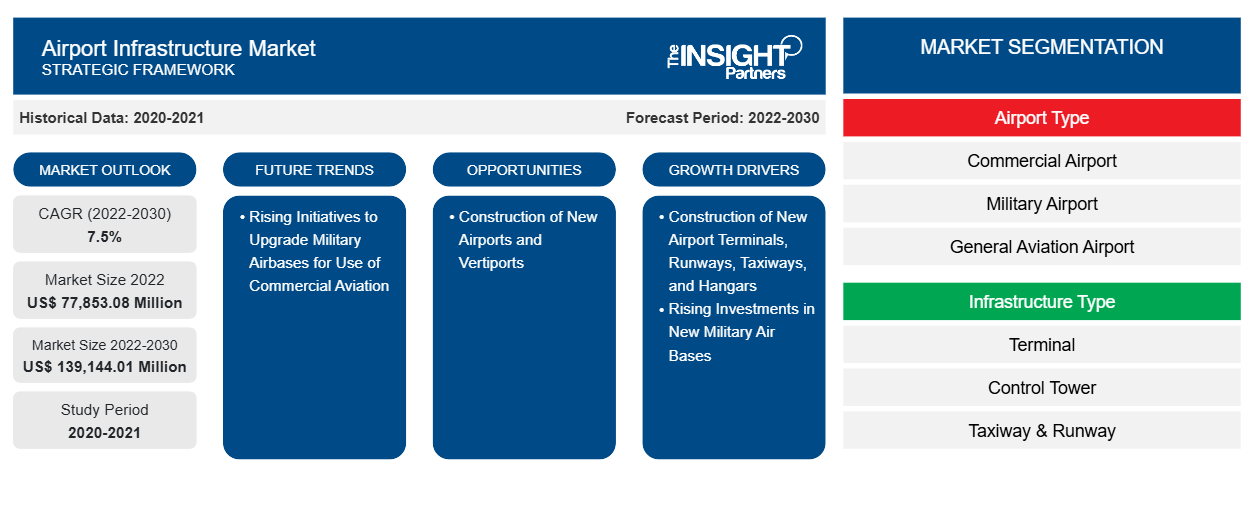Si prevede che la dimensione del mercato delle infrastrutture aeroportuali raggiungerà 139.144,01 milioni di $ entro il 2030 da 77.853,08 milioni di $ nel 2022. Si prevede che il mercato registrerà un CAGR del 7,5% nel 2022-2030. I governi di diversi paesi hanno preso iniziative per costruire nuovi aeroporti per soddisfare il crescente numero di flotte di aeromobili e passeggeri. Ad esempio, nel 2022, il governo indiano ha annunciato i suoi piani per costruire 220 aeroporti commerciali entro la fine del 2025. Inoltre, nel 2018, la Civil Aviation Administration of China (CAAC) ha annunciato i suoi piani per costruire 216 nuovi aeroporti entro la fine del 2035, il che aumenterà il numero totale di aeroporti a 450 entro il 2035 (234 aeroporti attualmente nel 2023). Tali sviluppi hanno spinto la crescita del mercato delle infrastrutture aeroportuali per il segmento degli aeroporti commerciali in tutto il mondo.
Analisi del mercato delle infrastrutture aeroportuali
La domanda di aeroporti militari e nuove basi aeree è in aumento a causa delle crescenti tensioni globali tra paesi di diverse regioni. Molti paesi hanno spinto i rispettivi investimenti militari per l'approvvigionamento di tecnologie legate alla missione e la costruzione di nuove basi nelle rispettive località target. Inoltre, l'espansione degli aeroporti militari esistenti per soddisfare un numero maggiore di velivoli militari ha spinto la crescita del mercato delle infrastrutture aeroportuali per il segmento degli aeroporti militari in tutto il mondo. Ad esempio, a settembre 2021, il governo cinese ha annunciato che erano stati costruiti 30 nuovi aeroporti nelle province del Tibet e dello Xinjiang per potenziare le infrastrutture aeroportuali civili e militari nelle regioni. Inoltre, sono stati anche annunciati in precedenza i piani dell'esercito indiano per la costruzione di 59 aeroporti. Entro la fine di novembre 2023, l'India aveva circa 39 aeroporti militari per le rispettive operazioni. Tali sviluppi hanno spinto la crescita del mercato delle infrastrutture aeroportuali per il segmento degli aeroporti militari .
Panoramica del mercato delle infrastrutture aeroportuali
L'aeroporto di aviazione generale serve fondamentalmente jet aziendali, aeromobili con motore a pistoni, elicotteri e aerei da addestramento per operazioni quali decollo, atterraggio, servizi MRO, controlli operativi e operazioni charter private. Diversi paesi, come Stati Uniti, Cina, Russia e Regno Unito, hanno già aeroporti di aviazione generale in numero maggiore, il che sta guidando la crescita del mercato delle infrastrutture aeroportuali per il segmento degli aeroporti di aviazione generale attraverso progetti di espansione aeroportuale nelle rispettive regioni. Ad esempio, a settembre 2023, uno dei principali aeroporti di aviazione generale (aeroporto di San Carlos) nella Bay Area di San Francisco, negli Stati Uniti, ha annunciato investimenti per l'ammodernamento dell'aeroporto con 50.000 piedi quadrati di nuovo spazio hangar e altri 22.000 piedi quadrati di area comune, spazi per uffici e sale riunioni. Inoltre, nel 2020, anche l'aeroporto internazionale Indira Gandhi di Delhi ha inaugurato un nuovo terminal per le operazioni di jet aziendali. Tali sviluppi hanno alimentato la crescita del mercato delle infrastrutture aeroportuali per il segmento degli aeroporti di aviazione generale.
Personalizza questo report in base alle tue esigenze
Riceverai la personalizzazione gratuita di qualsiasi report, comprese parti di questo report, o analisi a livello nazionale, pacchetto dati Excel, oltre a usufruire di grandi offerte e sconti per start-up e università
- Scopri le principali tendenze di mercato in questo rapporto.Questo campione GRATUITO includerà analisi di dati che spaziano dalle tendenze di mercato alle stime e alle previsioni.
Driver e opportunità del mercato delle infrastrutture aeroportuali
Aumento della costruzione di nuovi terminal aeroportuali, piste, vie di rullaggio e hangar
La crescente flotta globale di aeromobili commerciali è uno dei principali fattori che genera la domanda di nuovi voli, terminal, piste e hangar in diversi aeroporti per soddisfare il crescente traffico passeggeri in tutto il mondo. Ciò aumenta anche gli investimenti delle autorità aeroportuali per aggiornare i rispettivi locali aeroportuali per soddisfare un numero maggiore di aeromobili, il che migliora anche l'efficienza operativa complessiva dell'aeroporto. Ciò è anche supportato dall'introduzione di compagnie aeree low-cost che hanno supportato il traffico passeggeri aereo in tutto il mondo. A marzo 2023, il consiglio comunale canadese di Kelowna ha annunciato l'approvazione per un finanziamento di 90 milioni di dollari USA per il progetto di ampliamento del terminal dell'aeroporto di Kelowna. Anche diverse autorità governative di diversi paesi hanno pianificato di costruire nuovi aeroporti nei rispettivi paesi per migliorare il flusso del commercio internazionale di merci e il settore dei viaggi aerei. Ad esempio, negli Stati Uniti sono attualmente in costruzione sei nuovi aeroporti. Inoltre, nel 2022, il governo indiano ha annunciato i suoi piani per costruire 220 aeroporti entro la fine del 2025. Inoltre, nel 2018, la Civil Aviation Administration of China (CAAC) ha annunciato i suoi piani per costruire 216 nuovi aeroporti entro la fine del 2035 e probabilmente aumenterà il numero totale di aeroporti a 450 aeroporti entro il 2035 (234 aeroporti attualmente nel 2023). Pertanto, la costruzione di nuovi terminal aeroportuali, piste, vie di rullaggio e hangar contribuisce alla crescita del mercato delle infrastrutture aeroportuali in tutto il mondo.Kelowna City Council announced approval for funding of US$ 90 million for the expansion project of the Kelowna Airport terminal. Several government authorities of different countries have also been planning to construct new airports across their respective countries to enhance the flow of international cargo trade and the air travel industry. For instance, in the US, six new airports are currently under construction. Also, in 2022, the Government of India announced its plans to build 220 airports by the end of 2025. Moreover, in 2018, the Civil Aviation Administration of China (CAAC) announced its plans to construct 216 new airports by the end of 2035 and is likely to boost the total airport count to 450 airports by 2035 (234 airports currently in 2023). Thus, the construction of new airport terminals, runways, taxiways, and hangars contributes to the growth of the airport infrastructure market across the globe.
Crescenti iniziative per potenziare le basi aeree militari per l'uso dell'aviazione commerciale
I governi di diversi paesi hanno preso iniziative per consentire ai rispettivi aeroporti militari di atterrare e operare aerei commerciali, per offrire maggiore comodità nella gestione del crescente traffico passeggeri in diverse regioni, fino a quando non saranno operativi nuovi aeroporti commerciali. Alcune altre iniziative includono l'aggiornamento di aeroporti militari selettivi in aeroporti ibridi. Ad esempio, diversi aeroporti militari negli Stati Uniti, come AF Plant 42, Palmdale, CA; Barter Island LRRS, Barter Island; AK Charleston AFB, Charleston, SC; Dover AFB, Dover, DE; Eglin AFB, Valparaiso, FL; Grissom AFB, Peru, IN; e Kelly/Lackland AFB, TX consentono l'uso congiunto di questi aeroporti militari esistenti quando uno sponsor civile desidera utilizzare l'aeroporto militare per le sue operazioni di atterraggio o decollo. Pertanto, si prevede che le crescenti iniziative per aggiornare le basi aeree militari per l'uso dell'aviazione commerciale alimenteranno la crescita del mercato delle infrastrutture aeroportuali durante il periodo di previsione.
Analisi della segmentazione del rapporto di mercato sulle infrastrutture aeroportuali
I segmenti chiave che hanno contribuito alla derivazione dell'analisi del mercato delle infrastrutture aeroportuali sono il tipo di aeroporto, il tipo di infrastruttura e la geografia.
- In base al tipo di aeroporto, l'Airport Infrastructure Market è stato segmentato in aeroporto commerciale, aeroporto militare e aeroporto di aviazione generale. Il segmento degli aeroporti commerciali ha detenuto una quota di mercato maggiore nel 2022.
- In base al tipo di infrastruttura, l'Airport Infrastructure Market è stato segmentato in terminal, torre di controllo, pista di rullaggio, hangar e altri. Il segmento terminal ha detenuto la quota maggiore del mercato nel 2022.
Analisi della quota di mercato delle infrastrutture aeroportuali per area geografica
L'ambito geografico del rapporto sul mercato delle infrastrutture aeroportuali è suddiviso principalmente in cinque regioni: Nord America, Europa, Asia Pacifico, Medio Oriente e Africa e Sud America.
L'Asia Pacifica ha dominato il mercato delle infrastrutture aeroportuali nel 2022 e si prevede che manterrà il suo predominio anche durante il periodo di previsione. Inoltre, è probabile che la regione Asia Pacifica registri il CAGR più elevato nel mercato delle infrastrutture aeroportuali nel periodo 2022-2030. Ciò è dovuto a un aumento degli investimenti per l'espansione e la modernizzazione delle strutture aeroportuali nella regione. Inoltre, l'Asia Pacifica si pone come un hub dinamico per lo sviluppo delle infrastrutture aeroportuali, guidato dalla robusta crescita economica della regione e da un'impennata dei viaggi aerei. Paesi come Cina e India stanno assistendo a massicci investimenti in nuovi progetti di costruzione ed espansione degli aeroporti. Queste iniziative mirano a tenere il passo con l'aumento del numero di passeggeri e a promuovere la connettività regionale.
Approfondimenti regionali sul mercato delle infrastrutture aeroportuali
Le tendenze regionali e i fattori che influenzano il mercato delle infrastrutture aeroportuali durante il periodo di previsione sono stati ampiamente spiegati dagli analisti di Insight Partners. Questa sezione discute anche i segmenti e la geografia del mercato delle infrastrutture aeroportuali in Nord America, Europa, Asia Pacifico, Medio Oriente e Africa e Sud e Centro America.

- Ottieni i dati specifici regionali per il mercato delle infrastrutture aeroportuali
Ambito del rapporto sul mercato delle infrastrutture aeroportuali
| Attributo del report | Dettagli |
|---|---|
| Dimensioni del mercato nel 2022 | 77.853,08 milioni di dollari USA |
| Dimensioni del mercato entro il 2030 | 139.144,01 milioni di dollari USA |
| CAGR globale (2022-2030) | 7,5% |
| Dati storici | 2020-2021 |
| Periodo di previsione | 2022-2030 |
| Segmenti coperti | Per tipo di aeroporto
|
| Regioni e Paesi coperti | America del Nord
|
| Leader di mercato e profili aziendali chiave |
|
Densità degli attori del mercato delle infrastrutture aeroportuali: comprendere il suo impatto sulle dinamiche aziendali
Il mercato delle infrastrutture aeroportuali sta crescendo rapidamente, spinto dalla crescente domanda degli utenti finali dovuta a fattori quali l'evoluzione delle preferenze dei consumatori, i progressi tecnologici e una maggiore consapevolezza dei vantaggi del prodotto. Con l'aumento della domanda, le aziende stanno ampliando le loro offerte, innovando per soddisfare le esigenze dei consumatori e capitalizzando sulle tendenze emergenti, il che alimenta ulteriormente la crescita del mercato.
La densità degli operatori di mercato si riferisce alla distribuzione di aziende o società che operano in un particolare mercato o settore. Indica quanti concorrenti (operatori di mercato) sono presenti in un dato spazio di mercato in relazione alle sue dimensioni o al valore di mercato totale.
Le principali aziende che operano nel mercato delle infrastrutture aeroportuali sono:
- Autore: Hensel Phelps
- AECOM
- Società di costruzioni Turner
- Skanska
- Industrie di Austin
Disclaimer : le aziende elencate sopra non sono classificate secondo un ordine particolare.

- Ottieni una panoramica dei principali attori del mercato delle infrastrutture aeroportuali
Notizie e sviluppi recenti del mercato delle infrastrutture aeroportuali
Il mercato delle infrastrutture aeroportuali viene valutato raccogliendo dati qualitativi e quantitativi dopo la ricerca primaria e secondaria, che include importanti pubblicazioni aziendali, dati associativi e database. Di seguito è riportato un elenco degli sviluppi nel mercato per il mercato delle infrastrutture aeroportuali e delle strategie:
- Nel 2023, Hensel Phelps è stato nominato Construction Manager at Risk (CMaR) per il New Terminal Project presso l'aeroporto internazionale John Glenn Columbus dalla Columbus Regional Airport Authority (CRAA). Per il progetto, i servizi di pre-costruzione e costruzione saranno forniti dal team Hensel Phelps | Elford. Con questo progetto, Hensel Phelps entra nel mercato dell'Ohio e rafforza la sua partnership con CRAA ed Elford. (Fonte: Hensel Phelps, comunicato stampa/sito Web aziendale/newsletter)
- Nel 2022, AECOM ha annunciato che la sua joint venture con HJ Russell & Company, Airfield Management Partners, era stata selezionata per fornire servizi di gestione dei programmi e delle costruzioni civili lato volo presso l'aeroporto internazionale di Dallas Fort Worth. (Fonte: AECOM, comunicato stampa/sito Web aziendale/newsletter)
Copertura e risultati del rapporto sul mercato delle infrastrutture aeroportuali
Il rapporto “Dimensioni e previsioni del mercato delle infrastrutture aeroportuali (2020-2030)” fornisce un’analisi dettagliata del mercato che copre le seguenti aree:
- Dimensioni e previsioni del mercato a livello globale, regionale e nazionale per tutti i segmenti di mercato chiave coperti dall'ambito
- Dinamiche di mercato come fattori trainanti, vincoli e opportunità chiave
- Principali tendenze future
- Analisi dettagliata delle cinque forze di Porter
- Analisi di mercato globale e regionale che copre le principali tendenze di mercato, i principali attori, le normative e gli sviluppi recenti del mercato
- Analisi del panorama industriale e della concorrenza che copre la concentrazione del mercato, l'analisi della mappa di calore, i principali attori e gli sviluppi recenti
- Profili aziendali dettagliati con analisi SWOT
- Analisi storica (2 anni), anno base, previsione (7 anni) con CAGR
- Analisi PEST e SWOT
- Valore/volume delle dimensioni del mercato - Globale, Regionale, Nazionale
- Industria e panorama competitivo
- Set di dati Excel
Report recenti
Testimonianze
Motivo dell'acquisto
- Processo decisionale informato
- Comprensione delle dinamiche di mercato
- Analisi competitiva
- Analisi dei clienti
- Previsioni di mercato
- Mitigazione del rischio
- Pianificazione strategica
- Giustificazione degli investimenti
- Identificazione dei mercati emergenti
- Miglioramento delle strategie di marketing
- Aumento dell'efficienza operativa
- Allineamento alle tendenze normative























 Ottieni un campione gratuito per - Mercato delle infrastrutture aeroportuali
Ottieni un campione gratuito per - Mercato delle infrastrutture aeroportuali